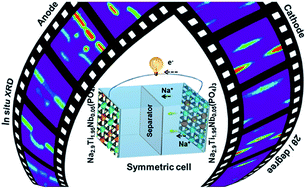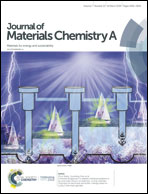Nb-Doped titanium phosphate for sodium storage: electrochemical performance and structural insights†
Abstract
The effect of Nb5+ doping on the electrochemical and structural characteristics of NaTi2(PO4)3 was investigated. The Nb5+ substitution lowered the band gap energy from 2.8 to 1.4 eV according to density functional theory calculations. Subsequent carbonization of pitch carbon on the surface of NaNbxTi2−x(PO4)3 (x = 0.05) significantly increased the electrical conductivity, thereby improving the capacity and high-rate capability. The excellent cyclability and superior electrode performance result from facile Na+ insertion and extraction that occur via a biphasic redox mechanism, namely, the Ti4+/3+ redox couple for the cathode and a sequence of two biphasic redox reactions associated with the Ti3+/2+ redox couple for the anode, as revealed by operando X-ray diffraction and ex situ X-ray absorption spectroscopic studies. Moreover, the possibility of application of Na2.9Nb0.05Ti1.95(PO4)3 as both a cathode and anode material was demonstrated in a symmetric cell, which delivered a capacity of 105 mA h g−1 after 100 cycles at 0.2C with a capacity retention of 83%.



 Please wait while we load your content...
Please wait while we load your content...